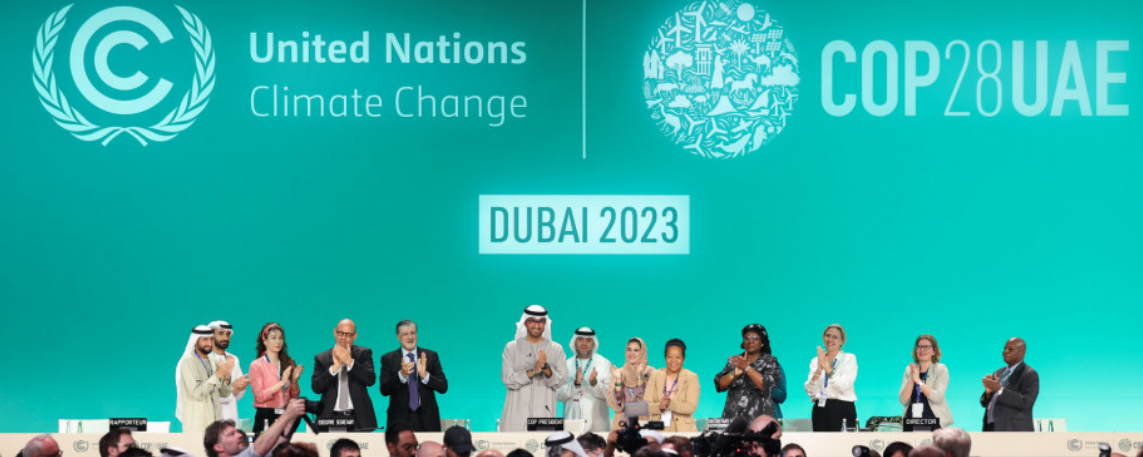
21 Dec 2023
COP28 Recognizes “Beginning of the End” of Fossil-Fuel Addiction
The most consequential COP conference since the first one almost three decades ago recently concluded in the UAE's major city of Dubai. The conference, a function of the United Nations and formally known as the Conference of the Parties, issued a final statement that explicitly mentioned a “phase down” of fossil fuels.
Nuclear power was put on the table, for the first time anywhere in 40 years. Everyone left at least a little bit dissatisfied, which is the sign of a negotiation in which everyone had to compromise.
As much of the world heads into its major holiday season, and all of the world prepares for the calendar New Year, leaders, activists, and onlookers can now sit back and reflect about what happened, and what may happen in 2024 and beyond.
Nuclear Shockwave
The announcement in support of nuclear power preceded COP28's official opening. It came as a shock, which was no doubt fully intended. It calls for a tripling of nuclear power worldwide by 2050. Nuclear currently provides about 15% of global electricity, or a steady-state 435 gigawatts. Tripling this would require an investment of around $2 trillion at current costs.
The fine details of a construction program of this scale will include training a new generation of nuclear engineers, not something that can happen overnight. Young people of the world should probably be aware that this field changed overnight from being one of the worst ideas for their education to one of the best.
There should also be many lively discussions on form factors – today's nuclear plants can typically put out 2 gigawatts (2,000 megawatts) at full power, in comparison to the smaller SMRs (small modular reactors) of 300 megawatts that have gained recent attention. Within that discussion are key strategies of the particular type of power plant to build, each with its own merits and disadvantages.
Compensation and Investment
Another early announcement involved a compensation fund of $720 million for nations that have claimed direct damages from climate change. This issue of reparations seems somewhat like re-arranging the deck chairs on the Titanic or arguing about how many angels can dance on the head of a pin while the pin itself seems headed to oblivion.
The Western world, along with China, will never agree to take such an initiative seriously or support it with anything substantial. Germany and Dubai both pledged $100 million to this fund, the US $17 million (equal to how much the US spends on its military every 12 minutes). On the other hand, this reporter spends a lot of time living in a modestly sized, tropical developing nation, so is quite familiar with the notion of being part of the grass that gets trampled when elephants fight in it.
Yet it seems that all the anger from smaller countries over this issue will continue to be for almost naught. Much more important is the much larger climate investment commitment from developed nations, which will reach almost $90 billion this year.
The Oil-Nation Backdrop
The COP meetings are scheduled to last two weeks, and sometime run a day or two longer (as it did this year) to hammer out some sort of final agreement.
IDCA reported on the conference's first half a few days ago; the second half, symbolically and literally heralded by the arrival of Saudi Arabia's oil minister, Abdulaziz bin Salman, featured a ramped-up intensity over the issue of future fossil-fuel usage and the reality of the world's major climate-change conference being hosted by an oil nation.
(Although Dubai has decreased its oil dependence to less than 10% of its economy, COP28 was hosted by the chair of Abu Dhabi's national oil company, Sultan al-Jaber. The UAE as a whole is the world's seventh largest oil-producing nation.)
Saudi Arabia, the UAE and other Middle Eastern oil nations do not fare well in the Environment category of IDCA's Digital Readiness of Nations research. Yet the Saudis have openly been working to diversify their nation's economy since at least 2014 and a dramatic report issued at the G20 summit in Brisbane.
The Hard Part Ensues
The arrival of bin Salman signaled “the hard part” of COP28, according to al-Jaber, as conference delegates strove to reconcile the ongoing requirements of an oil-thirsty world and the widely accepted need to get this world to drink renewable energy in all of its flavors.
After many long nights and much wrought discussion that ran into overtime, the final statement did not include the phrase “phase out” with respect to fossil fuels, but did mentioned “transition away from fossil fuels...in a just, orderly and equitable manner...so as to achieve net zero by 2050 in keeping with the science." Even strong critics of this agreement, such as the Alliance of Small Island States, did not formally object to it.
Fast Forward & Flashback
The next conference, COP29, will be held in Azerbaijan, another oil nation that is part of the semi-formal “OPEC+ format.” Brazil, a nation with its own formidable environmental challenges (yet a strong performer in the IDCA Digital Readiness Index) is the current favorite to host COP30.
The first COP conference, COP1, was held in 1995 in Berlin. It focused on creating what became known as the Kyoto Protocol in 1997, and which was adopted (and famously rejected by the George W. Bush administration) in the US in 2005. Now, almost three decades later, the US has been surpassed (in fact, doubled) in its emissions totals by China, even as it remains the number two emissions producer in the world.
What About the Economy?
COP28 (and all other climate-change discussions) are held within the context of getting to Net Zero some day while continuing the support economic development, particularly in developing nations. This can feel like working with inextricably contradictory goals.
Addressing this issue, IDCA Research measures emissions from several viewpoints – uniquely, among the viewpoints is a look at national emissions levels correlated with the size of GDP. This gives a better picture than simple per-capita emissions, which don't account for economic development or the differences in severity of summers and winters around the world.
A better question is, “how efficient is a nation in producing economic output?” By looking at the number of tons of CO2 per $1 million of GDP, it's seen that top emissions producer China is only about 50% as efficient as the US, number three producer India only about 30% as the US, and almost 100 among the 150 nations surveyed are less efficient than the US.
If China and India were to become as efficient in their emissions output as the US overnight, the level of global emissions would drop 20% instantly. If the entire world were to match the US overnight, total emissions would drop 37% instantly.
What About the US and China?
This is not to say that US serves as a model. There are 50 nations more efficient than the US, including much of the EU, and several developing nations with considerable hydropower resources. Yet, unless and until the US and China can get on the same page about almost everything, and bring India into serious discussions, it seems that COP meetings will not be as effective as many would wish.
What is COP28's True Meaning?
COP28 concluded with what can be viewed as the first substantial recognition that fossil-fuel dependence has reached
* “The beginning of the end,” in the words of UN Climate Change Executive Secretary Simon Stiell
* More cynical kicking of the can down the road (the nuclear commitment mentions 2050, for example
* A hardheaded, practical approach that recognizes the world's oil addiction yet is trying to implement a multi-step approach to overcome it
* Some other interpretation that readers of this article may have.
Please let us know your opinions.
(Photo from United Nations.)
Follow us on social media:


.d57b427b.png&w=3840&q=75)

















